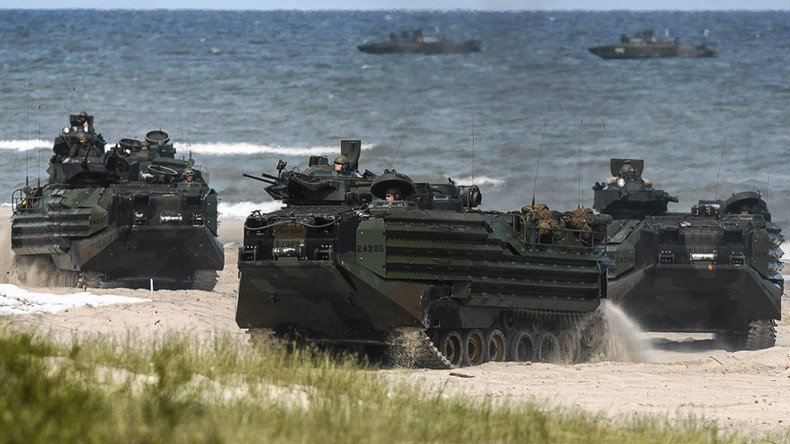Russia offers NATO an olive branch, but is reconciliation in NATO interests?

Russia has invited NATO’s military experts to Moscow in September and offered a “positive program” for developing relations with the military alliance — but is reconciliation really what NATO is interested in?
Russian Deputy Defense Minister Anatoly Antonov said the proposal was aimed at decreasing tensions and that Moscow was ready for a constructive approach, despite differences between the two sides. Antonov said the meeting would promote a "de-escalation of tensions and prevent military incidents on the contact line between the sides’ armed forces”.
This is Moscow’s response to the NATO Summit held in Warsaw in July, at which it was confirmed that four more NATO battalions would be deployed to eastern European NATO states. The bloc also reaffirmed at the summit its contention that Moscow is a “source of instability” in the region.
An olive branch
If you were a pessimist, you might write off Russia’s move as all talk and no action — but it’s actually been backed up with at least one concrete public proposal: safer flights over the Baltic “as a matter of priority” if both parties agree. Antonov said Russia was ready to address “mutual concerns” with its neighbors over military activity in border areas.
NATO and Russia have traded accusations over their respective activities in the Baltic. NATO has repeatedly accused Russia of flying its jets over the region with transponders switched off, while Moscow has returned the same accusation — adding that an alternative approach would simply be to cease flights near the Russian border.
MORE: Russian Ministry of Defense invites NATO for talks https://t.co/A8DHJjWJBnpic.twitter.com/qpxbTs3Knh
— RT (@RT_com) August 1, 2016
Whatever one may say about Russia and its role in the current conflict with NATO, this looks very much like a genuine effort to improve relations with the Western military bloc. Given the level of hostility between the two recently, it might have been expected that any kind of olive branch offered by Russia would be well-received.
Strangely, though, while the offer to perform safer sorties did receive some attention in recent weeks, the public invitation to embark on a joint program for developing relations in general, has so far at least, elicited very little public response from NATO and garnered scant media attention. One of the only responses has come from non-NATO member Finland’s ministry of defense, which released a statement calling Moscow’s initiative “interesting”. Estonia’s defense ministry has said it would carefully consider whether or not to attend consultations with Moscow in September, and others have said that no official invitation has yet been extended.
But does NATO really want to mend fences with Russia? A little historical context is necessary to answer that question.
In search of a mission
In 1951, NATO’s first supreme allied commander, General Dwight D. Eisenhower remarked: "If in 10 years, all American troops stationed in Europe for national defense purposes have not been returned to the United States, then this whole project will have failed."
NATO missile defense goes live in Europe, isolating Russia not the goal – Stoltenberg https://t.co/hzCkN3l7yw#WSEF16
— RT (@RT_com) July 9, 2016
By that measure, the NATO project has well and truly failed: Sixty-five years on, American troops remain in eastern Europe, NATO has expanded eastward to Russia’s doorstep and recently launched the biggest war game exercises in the region since the end of the Cold War. Even the German foreign minister Frank-Walter Steinmeier warned that such “loud saber-rattling and shrill war cries” directed at Russia would serve no one.
"Whoever believes that symbolic tank parades on the alliance's eastern border will bring more security is mistaken. We are well-advised not to create pretexts to renew an old confrontation,” he continued.
When the Soviet Union ceased to exist in 1991, the alliance found itself with a bad case of thumb twiddling. The authors of an op-ed about NATO expansion published by the Chicago Tribune in 1994 noted: “The first priority of any bureaucratic institution is to perpetuate its existence. The second is to expand its functions.”
And that’s exactly what NATO did: It perpetuated its existence by offering membership to more and more states, and expanded its functions by entering the business of fighting global terrorism and engaging in regime-change operations. Both, to say the least, have had mixed results. In Europe, experts are increasingly inclined to call the latest stand-off between NATO and Russia a ‘new Cold War’ — while further afield, NATO interventions have wreaked havoc in the Middle East, helping to fuel the rise of Islamic State.
Russian military build ups are "aggression"
— Adam H. Johnson (@adamjohnsonNYC) March 30, 2016
NATO military build ups are "deterrents" https://t.co/Va9lY1qkagpic.twitter.com/g9RN8BlS2L
Lining their pockets
But if there was no threat from Russia post-1991, why then did the alliance continue to expand at all? Feast your eyes on an article brought to Twitter’s attention by journalist Mark Ames. Published by the New York Times in 1998, it explained that American arms manufacturers “who stand to gain billions of dollars in sales of weapons, communication systems and other military equipment” were spending millions lobbying for the expansion of NATO.
Enlarging the bloc, the Times reported “would offer arms makers a new and hugely lucrative market”. NATO was central to their lobbying efforts because it simply offered “so many opportunities”.
NATO rules conveniently required new members to upgrade their militaries, replacing old Soviet-made systems. Thus, the sums arms makers spent on lobbying were “relatively small compared with the potential benefits in the new markets provided by a larger NATO, particularly from the sale of big-ticket items like fighter aircraft,” the Times report said.
US military contractors spent millions lobbying for NATO expansion, stood to gain billions (via @MarkAmesExiled) pic.twitter.com/KIOh7ErcFX
— Danielle Ryan (@DanielleRyanJ) August 4, 2016
Despite the fact that the biggest beneficiaries were American military contractors, the US still contended that NATO was being expanded to ‘unite’ and ‘stabilize’ Europe. The fact that Russia — a significant part of Europe — was being locked out of the new European ‘security’ structure didn’t seem to bother anyone.
The Times report quoted a Republican aide who joked that the contractors were so eager to sell arms that they’d “probably be giving landlocked Hungary a new navy”. Another aide told the Times that Americans themselves didn’t really care about NATO expansion: “The only people who care about this are the think-tank folks and the academics,” he admitted.
Yet today Americans are told they must indeed care about NATO — and they must care about it a lot. When presidential candidate Donald J. Trump suggests that NATO members not paying their bills should cough up or defend themselves, it prompts uproar. Washington’s relationship with its allies in Eastern Europe is sacrosanct, we’re told. It’s all about unity, stability, butterflies and unicorns.
But has the real mission changed? Well, given that the US last year launched a special NATO weapons program aimed at helping struggling NATO members share costs and buy American weapons together, the answer to that is probably “no”.
Ongoing tensions in Europe keep the defense dollars rolling in. Russia doesn’t need to be a real threat for this to work. It can just as easily be an imagined one. To keep small and relatively weak NATO members like the Baltics in a state of permanent fear and paranoia, Washington must convince them that they could be invaded by the Russian bear at any minute. In fact, a letter to the Irish Times recently from a retired army officer even argued: “A limited but devastating war in Europe could suit the economic interests of the US elite” so long as it was maintained at a non-nuclear and regional level.
NATO’s primary purpose today therefore is to create threats, real or imaginary, in the minds of its members, allowing US defense contractors to rush in and sell outrageously expensive weaponry to those nations. The ‘Russia threat’ also provides a similarly excellent excuse to maintain astronomically high US defense spending.
No one is suggesting that NATO actually wants full-scale war with Russia or that Vladimir Putin is a victimized angel — just that Russia can fill the role of convenient bogeyman rather brilliantly simply by existing.
Moscow’s latest offer to embark on a “positive program” for developing friendly relations with NATO already looks dead in the water when you look at it that way.
The statements, views and opinions expressed in this column are solely those of the author and do not necessarily represent those of RT.














